the polish-jewish-ukrainian relations in wielkie oczy - JewishGen ...
the polish-jewish-ukrainian relations in wielkie oczy - JewishGen ...
the polish-jewish-ukrainian relations in wielkie oczy - JewishGen ...
You also want an ePaper? Increase the reach of your titles
YUMPU automatically turns print PDFs into web optimized ePapers that Google loves.
Urszula Kaciuba, age 15<br />
The Jan Kochanowski Grammar School No 1 <strong>in</strong> Wielkie Oczy<br />
THE POLISH-JEWISH-UKRAINIAN RELATIONS IN WIELKIE OCZY<br />
Wielkie Oczy is a village located now <strong>in</strong> Podkarpackie Prov<strong>in</strong>ce,<br />
Lubaczów County. The Wielkie Oczy adm<strong>in</strong>istrative district<br />
(gmnia) <strong>in</strong>cludes <strong>the</strong> follow<strong>in</strong>g villages: Kobylnica Woloska,<br />
Kobylnica Ruska, Potok Jaworowski, Lukawiec, Majdan, Bihale,<br />
Skol<strong>in</strong>, Zmijowiska, Wólka Zmijowska.<br />
The district is 147 sq. km <strong>in</strong> area and has an agricultural character.<br />
Accord<strong>in</strong>g to <strong>the</strong> local legend <strong>the</strong> name (Big Eyes - <strong>in</strong> Polish)<br />
comes from two big ponds that once were here and that looked<br />
like two big eyes. In Yiddish <strong>the</strong> name sounds like Vilkotch or<br />
Vielkatchi and <strong>in</strong> Ukra<strong>in</strong>ian, Velyki Otchi.<br />
Now Wielkie Oczy is a small village, a center of <strong>the</strong> local adm<strong>in</strong>istrative<br />
district (gmnia), and <strong>the</strong> traces of past can still be seen<br />
here. These traces memorialize <strong>the</strong> days of magnificence of<br />
Wielkie Oczy. They are also evidence of <strong>the</strong> peaceful coexistence<br />
of three nationalities: Polish, Jewish and Ukra<strong>in</strong>ian. That<br />
<strong>the</strong>se three nations came toge<strong>the</strong>r here was because of <strong>the</strong><br />
geographic, mercantile and strategic location of <strong>the</strong> village.<br />
There are different versions of how Wielkie Oczy came to be.<br />
Some sources talk about <strong>the</strong> 14th century, o<strong>the</strong>rs about 16th.<br />
The village was <strong>in</strong> <strong>the</strong> possession of many families. One of<br />
<strong>the</strong>m, a cavalry capta<strong>in</strong> by <strong>the</strong> name of Andrzej Modrzejowski,<br />
secured for Wielkie Oczy <strong>the</strong> rights of a town to hold different<br />
privileges: markets every Thursday and fairs three times a year.<br />
As a result trade developed, helped also by <strong>the</strong> location of <strong>the</strong><br />
village on <strong>the</strong> way from Jaworów to Jaroslaw, and many Jewish<br />
families settled here. It is known that <strong>in</strong> 1717 <strong>the</strong> Wielkie Oczy<br />
Jews paid a poll tax of 772 zloty and 40 years later <strong>the</strong>re existed<br />
a relatively big Jewish community. In <strong>the</strong>se times lived<br />
here a very famous rabbi Mordechai ben Shmuel from Kutno,<br />
an author of <strong>the</strong> religious treaty "K<strong>in</strong>g's Gate".<br />
In 1799 <strong>in</strong> Wielkie Oczy <strong>the</strong>re were 179 houses, 1087 residents<br />
and between <strong>the</strong>m 402 Jews. In 1880 this number <strong>in</strong>creased to<br />
996 Jews, 589 Poles and 388 Ukra<strong>in</strong>ians. Dur<strong>in</strong>g <strong>the</strong> 19th century<br />
trade was developed ma<strong>in</strong>ly by Jews, who were 50% of <strong>the</strong><br />
population. Between trade enterprises <strong>the</strong>re were also two tanneries,<br />
two brick yards, a steam mill, a slaughterhouse and 4<br />
alcohol distilleries.<br />
In <strong>the</strong> 1866 fire 15 Jewish houses were destroyed and <strong>the</strong> rema<strong>in</strong>s<br />
were stolen (probably by Ukra<strong>in</strong>ians who lived <strong>in</strong> <strong>the</strong><br />
neighborhood). The next damage to <strong>the</strong> Jews occurred <strong>in</strong> 1910,<br />
when a Ukra<strong>in</strong>ian priest stirred people up and <strong>the</strong>y beat some<br />
Jews and destroyed <strong>the</strong>ir property. This <strong>in</strong>cident ended only<br />
after <strong>the</strong> police arrived. At <strong>the</strong> end of <strong>the</strong> century many Jews<br />
emigrated, ma<strong>in</strong>ly to America, look<strong>in</strong>g for better liv<strong>in</strong>g conditions.<br />
Their number decreased to 862 of a total population of<br />
2,037. In 1910 <strong>the</strong> synagogue was built <strong>in</strong> <strong>the</strong> market place.<br />
In <strong>the</strong> first days of WWI Wielkie Oczy was captured by Russians.<br />
The defenders killed a Russian scout. Later it appeared<br />
that <strong>the</strong> scout was a pious Jew, and <strong>in</strong> accordance with <strong>the</strong><br />
1<br />
demands of a Russian officer <strong>the</strong> scout was given a religious<br />
burial.<br />
In June 1915 <strong>the</strong> Russians retreated before <strong>the</strong> Germans and<br />
<strong>the</strong>y set fire to <strong>the</strong> build<strong>in</strong>gs of Wielkie Oczy, ma<strong>in</strong>ly to those<br />
around <strong>the</strong> market place. The synagogue and <strong>the</strong> Ukra<strong>in</strong>ian<br />
church were also burned.<br />
After <strong>the</strong> WWI <strong>the</strong> population of Wielkie Oczy decreased by<br />
25%. The total population was 1,552: Poles 768, Jews 487 and<br />
Ukra<strong>in</strong>ians: 297.<br />
In 1925 <strong>the</strong> school system was reorganized and a 7-level state<br />
primary school was established. Some 200 Polish, Jewish and<br />
Ukra<strong>in</strong>ian children studied <strong>in</strong> this school. The houses of worship,<br />
<strong>the</strong> synagogue and <strong>the</strong> Ukra<strong>in</strong>ian church, were rebuilt.<br />
The funds for synagogue renovation were raised by Jewish<br />
emigrants from Wielkie Oczy.<br />
In <strong>the</strong> period between <strong>the</strong> world wars <strong>the</strong>re were no big conflicts<br />
among <strong>the</strong> population of Wielkie Oczy. Three cultures coexisted.<br />
There was mutual respect and visits; ma<strong>in</strong> holidays<br />
were celebrated toge<strong>the</strong>r. Religious dignitaries were solemnly<br />
welcomed.<br />
Before WWII Jews were ma<strong>in</strong>ly traders. They had about 30<br />
shops. They were department stores (mostly with food products),<br />
haberdashers and shops with sk<strong>in</strong>s for shoes. In <strong>the</strong> entry<br />
of every shop was a little bell that signaled when customers<br />
arrived. The shopkeeper was often absent because <strong>the</strong> shops<br />
were located <strong>in</strong> <strong>the</strong> Jewish houses [where <strong>the</strong> shopkeeper also<br />
lived]. It was possible to run up an account. People were said<br />
"to buy on <strong>the</strong> book". Of course, <strong>the</strong> debt was later settled, <strong>in</strong>clud<strong>in</strong>g<br />
<strong>in</strong>terest, <strong>in</strong> most cases by someth<strong>in</strong>g from <strong>the</strong> house,<br />
such as a chicken, eggs, etc.<br />
Here are <strong>the</strong> names of some Jews and <strong>the</strong>ir occupation:<br />
• Giecyl - bought cows and sold <strong>the</strong>m <strong>in</strong> Jaworow;<br />
• Wais (Weiss?) - haberdasher's shop;<br />
• Klang - haberdasher's shop;<br />
• Taler - grocer's shop;<br />
• Tandalaj - clo<strong>the</strong>s shop (was a tailor);<br />
• Halper - tailor;<br />
• Just - <strong>in</strong>n owner;<br />
• Majus - shop with hats;<br />
• Kunio - butcher;<br />
• Jukiel - butcher<br />
• Malka - a little grocer's shop;<br />
• Srulka (a nickname?) - textile shop<br />
• Brener - squire's woods adm<strong>in</strong>istrator<br />
• Bleiberg - a teacher<br />
• Tadeusz Gr<strong>in</strong>zajd - doctor<br />
• Kilhawer - was an owner of <strong>the</strong> fields, Poles and<br />
Ukra<strong>in</strong>ians worked for him;
• Lypa - was a poor Jew (brought water to richer people,<br />
and <strong>in</strong> this way earned a liv<strong>in</strong>g)<br />
In Wielkie Oczy <strong>the</strong>re were three Jewish dairies. Jews also<br />
worked <strong>in</strong> handicrafts. They owned two big tailor<strong>in</strong>g enterprises,<br />
and <strong>the</strong>y also taught Poles to sew. There were also two bakeries.<br />
Only Jews worked <strong>in</strong> <strong>the</strong> bakeries. The made bread, bread<br />
rolls and sweet buns, which <strong>the</strong>y called lejka. Jews distributed<br />
<strong>the</strong>m personally to <strong>the</strong> houses (<strong>the</strong>y went to <strong>the</strong> houses, where<br />
<strong>the</strong>y expected to be paid for <strong>the</strong>ir products or to get some<br />
goods, milk for example). They also dealt with mobile trade.<br />
They engaged for this reason carters with carts and horses.<br />
(Jews <strong>the</strong>mselves didn’t raise horses).<br />
Jews didn’t kill animals at <strong>the</strong>ir houses. Slaughter<strong>in</strong>g was done<br />
<strong>in</strong> slaughterhouses, so called jatka. There were four slaughterhouses<br />
and 4 <strong>in</strong>ns managed by Jews, where ma<strong>in</strong>ly alcohol<br />
dr<strong>in</strong>ks were served and visitors brought someth<strong>in</strong>g to eat.<br />
Polish and Jewish children learned toge<strong>the</strong>r <strong>in</strong> <strong>the</strong> school. They<br />
attended all lessons toge<strong>the</strong>r, except for religion. Before <strong>the</strong><br />
religion lessons Jews left <strong>the</strong> classroom. Beside <strong>the</strong> primary<br />
school <strong>in</strong> Wielkie Oczy were two Jewish schools, so called<br />
cheders. Probably, <strong>the</strong> religion was taught <strong>the</strong>re.<br />
Jews helped <strong>the</strong> poorer of <strong>the</strong>m.<br />
The bath was managed by <strong>the</strong> Jew Mojsiu. Poles took <strong>the</strong>re<br />
baths as payment. It was <strong>in</strong> a wooden house. It stood <strong>in</strong> <strong>the</strong><br />
place called Pasternik, beh<strong>in</strong>d <strong>the</strong> synagogue. Inside was<br />
wooden well with crank. Close to <strong>the</strong> well was a pool called a<br />
kuszer only for Jews. For Poles <strong>the</strong>re was a special room with<br />
wooden bathtubs. Hot water was taken from a boiler (a lot of<br />
steam went from it). Close to <strong>the</strong> boiler were about eight<br />
wooden stairs. People sat on <strong>the</strong>m. It was a k<strong>in</strong>d of sauna. Inside<br />
it was semi-dark because <strong>the</strong> light came from one paraff<strong>in</strong><br />
lamp. Poles used to take a bath on Saturday even<strong>in</strong>g after <strong>the</strong><br />
Sabbath (before Sunday). Jews took <strong>the</strong>ir bath on Friday, because<br />
<strong>the</strong>ir Sabbath began Friday afternoon. Dur<strong>in</strong>g Sabbath<br />
Jews did not work, and <strong>the</strong>y would pay a so called goy to<br />
work. On Saturdays <strong>the</strong>y always ate chicken broth with potatoes.<br />
They also ate veal, but only <strong>the</strong> front parts of <strong>the</strong> animal.<br />
The back parts <strong>the</strong>y sold. Dur<strong>in</strong>g Saturdays <strong>the</strong>y prayed <strong>in</strong> <strong>the</strong><br />
synagogue and afterward celebrated <strong>the</strong> holiday at home with<br />
<strong>the</strong>ir families. Dur<strong>in</strong>g some holidays, probably <strong>in</strong> October, but I<br />
don't know what holidays <strong>the</strong>y were, Jews prayed <strong>in</strong> so called<br />
kuczki. It was like our summer-kitchen. The walls were made<br />
from bean-stalks. Dur<strong>in</strong>g holidays <strong>the</strong>y used o<strong>the</strong>r kitchen utensils<br />
<strong>the</strong>n dur<strong>in</strong>g <strong>the</strong> week-days.<br />
Dur<strong>in</strong>g holidays <strong>in</strong> spr<strong>in</strong>g Jews ate matzo. It is big, th<strong>in</strong> bread<br />
baked on leaven.<br />
Jewish wedd<strong>in</strong>g ceremonies, so called mazaltop, were held on<br />
Saturday even<strong>in</strong>gs. The ceremony was held <strong>in</strong> <strong>the</strong> synagogue<br />
or close to it under a canopy that looked like umbrella. On <strong>the</strong><br />
way out <strong>the</strong>y broke glasses. A modest party was held at home.<br />
They drank a quart of vodka, ate chicken or goose (depend<strong>in</strong>g<br />
on <strong>the</strong>ir level of wealth). There were not a varieties of cakes.<br />
Usually <strong>the</strong>y baked only one cake that looked like dark honeycake.<br />
2<br />
The bride had a crown on her head and dressed long white<br />
dress. The groom dressed black suit and k<strong>in</strong>d of bowler hat. No<br />
music was played. The visitors sang by <strong>the</strong>mselves and<br />
danced.<br />
A funeral was a sorrowful ceremony. The body of <strong>the</strong> dead was<br />
not <strong>in</strong> <strong>the</strong> coff<strong>in</strong>, it was wrapped <strong>in</strong> white sheet. The body was<br />
taken on <strong>the</strong> bier to <strong>the</strong> Jewish cemetery and buried. The funeral<br />
attendants prayed at <strong>the</strong> grave. The widow or widower<br />
didn’t enter <strong>the</strong> cemetery. They stayed before <strong>the</strong> gate. Children<br />
did not attend <strong>the</strong> funerals.<br />
In Wielkie Oczy, besides a large farm, <strong>the</strong>re were smaller farms<br />
<strong>in</strong> <strong>the</strong> woods close to Majdan. It was called Korczunek. There<br />
was built a big wooden house, covered by red roof<strong>in</strong>g-tiles, and<br />
<strong>the</strong>re lived five workers families: Mroczkowski, Trela, Barczyk,<br />
Szal and Szuszkiewicz. There were also big wooden stable and<br />
barn. These two build<strong>in</strong>gs were called gumno. All <strong>the</strong> works <strong>in</strong><br />
<strong>the</strong> farm was managed by a Jew by <strong>the</strong> name of Strassberg.<br />
The Ukra<strong>in</strong>ian church of St. Nicholas, <strong>the</strong> Miracle Worker, was<br />
rebuilt <strong>in</strong> 1925. It served about 45 Ukra<strong>in</strong>ian families. The<br />
Ukra<strong>in</strong>ians (or Ru<strong>the</strong>nians, as <strong>the</strong>y were called), were farmers.<br />
The dwellers of Wielkie Oczy attended <strong>the</strong> catholic church or<br />
Ukra<strong>in</strong>ian church. Mixed marriages were common. Children<br />
from such marriages were baptized <strong>in</strong> <strong>the</strong> Catholic church or<br />
Ukra<strong>in</strong>ian church, depend<strong>in</strong>g on <strong>the</strong> religion of <strong>the</strong>ir fa<strong>the</strong>rs or<br />
mo<strong>the</strong>rs - girls accord<strong>in</strong>g to belief of mo<strong>the</strong>rs, boys - accord<strong>in</strong>g<br />
to belief of fa<strong>the</strong>rs. In such families both Roman-Catholic and<br />
Greek-Catholic holidays were celebrated. People visited and<br />
greeted each o<strong>the</strong>r.<br />
On January 19 Ukra<strong>in</strong>ians used to celebrate <strong>the</strong> Jordan Holidays<br />
<strong>in</strong> Wielkie Oczy. On this day two processions marched<br />
with flags and holy pictures, one from <strong>the</strong> Ukra<strong>in</strong>ian church, <strong>the</strong><br />
second from <strong>the</strong> Catholic church. Both processions would <strong>the</strong>n<br />
meet at <strong>the</strong> market square <strong>in</strong> <strong>the</strong> center of <strong>the</strong> village and bow<br />
<strong>the</strong>ir flags to each o<strong>the</strong>r. The priests greeted each o<strong>the</strong>r. Fur<strong>the</strong>r<br />
away <strong>the</strong> processions would walk toge<strong>the</strong>r up to <strong>the</strong> Gron<br />
river, where <strong>the</strong>y blessed <strong>the</strong> water.<br />
Good <strong>relations</strong> were fostered by <strong>the</strong> Ukra<strong>in</strong>ian priest Eustachy<br />
Cep<strong>in</strong>ski. He came to Wielkie Oczy on holidays from Zmijowiska,<br />
where <strong>the</strong>re was a Greek-Catholic parish and cemetery.<br />
The conflicts started dur<strong>in</strong>g <strong>the</strong> WWII (1941-1942). The provocateurs<br />
were ma<strong>in</strong>ly <strong>the</strong> Ukra<strong>in</strong>ian priests Tarasewicz and<br />
Hal<strong>in</strong>ka. They <strong>in</strong>cited a differentiation and separation among<br />
<strong>the</strong> local population. The <strong>in</strong>cident by <strong>the</strong> wayside shr<strong>in</strong>e of St.<br />
John is remembered as a time when <strong>the</strong> Ukra<strong>in</strong>ian priest had<br />
an ear<strong>the</strong>n mound built <strong>the</strong>re to bury <strong>the</strong> “Polish shackles” that<br />
threatened Ukra<strong>in</strong>ian national aspirations. In <strong>the</strong> follow<strong>in</strong>g years<br />
Wielkie Oczy was attacked a number of times by <strong>the</strong> UPA, <strong>the</strong><br />
Ukra<strong>in</strong>ian Insurgent Army, units that murdered <strong>the</strong> Polish population.<br />
The aim was expulsion of <strong>the</strong> Poles from <strong>the</strong> village.<br />
Dur<strong>in</strong>g <strong>the</strong> even<strong>in</strong>g of July 20, 1944 Wielkie Oczy was attacked<br />
by units of Zalizniak and Kruk or Jastrub and <strong>the</strong> wooden<br />
houses of Poles were burned. The property was looted. Some<br />
who rema<strong>in</strong>ed hid <strong>in</strong> <strong>the</strong> church, where <strong>the</strong>y stayed until dawn,
<strong>in</strong> spite <strong>the</strong> attack of <strong>the</strong> UPA. In <strong>the</strong> morn<strong>in</strong>g Poles left <strong>the</strong>ir<br />
homes and escaped to Radymno, beh<strong>in</strong>d <strong>the</strong> San river.<br />
Many Jews escap<strong>in</strong>g before <strong>the</strong> Germans <strong>in</strong> 1939 stayed <strong>in</strong><br />
Wielkie Oczy. Some of <strong>the</strong>m found jobs here, o<strong>the</strong>rs cont<strong>in</strong>ued<br />
<strong>the</strong>ir escape fur<strong>the</strong>r to <strong>the</strong> East. The population received identity<br />
cards with special sign of <strong>the</strong> nationality: P for Poles, U for<br />
Ukra<strong>in</strong>ians and J for Jews.<br />
Adm<strong>in</strong>istrative power was granted by <strong>the</strong> Germans to <strong>the</strong> local<br />
Ukra<strong>in</strong>ians. The persecution of Jews started. Some Ukra<strong>in</strong>ians,<br />
co-dwellers and neighbors collaborated with <strong>the</strong> Germans <strong>in</strong><br />
<strong>the</strong>ir persecution of <strong>the</strong> Jews.<br />
On June 10, 1942, <strong>the</strong> Wielkie Oczy Jews were removed to<br />
ghettos <strong>in</strong> Krakowiec and Jaworów. They ga<strong>the</strong>red <strong>in</strong> <strong>the</strong> market<br />
place and sat <strong>in</strong> a circle. They were guarded and prevented<br />
from escap<strong>in</strong>g. Jews could take from <strong>the</strong>ir homes only <strong>the</strong> most<br />
necessary th<strong>in</strong>gs, what <strong>the</strong>y could carry with <strong>the</strong>ir hands. They<br />
made <strong>the</strong>ir way to <strong>the</strong> ghettos on foot. Only elderly persons and<br />
little children were taken on horse carts. The total number of<br />
forced to leave was 422; about 100 hundred escaped to <strong>the</strong><br />
woods. Ukra<strong>in</strong>ian police were told to f<strong>in</strong>d <strong>the</strong>m and send <strong>the</strong>m<br />
to <strong>the</strong>ir families <strong>in</strong> <strong>the</strong> ghetto. However, those who were caught<br />
3<br />
were shot. Also <strong>the</strong>se Jews who survived <strong>the</strong> war and came<br />
back to Wielkie Oczy were killed.<br />
The houses of <strong>the</strong> Jews (96) were sealed and later along with<br />
<strong>the</strong>ir furnish<strong>in</strong>g were granted to Ukra<strong>in</strong>ians settlers.<br />
Time has not erased all traces of <strong>the</strong> past <strong>in</strong> Wielkie Oczy. The<br />
past exists <strong>in</strong> build<strong>in</strong>gs, memorial plaques and <strong>in</strong> <strong>the</strong> m<strong>in</strong>ds of<br />
<strong>the</strong> people. The traces are evidence for <strong>the</strong> co-existence of<br />
people of different cultures, mutual respect and tolerance. The<br />
former multi-culture is seen ma<strong>in</strong>ly <strong>in</strong> <strong>the</strong> market square, where<br />
close to each o<strong>the</strong>r three prayer houses exist: Roman Catholic<br />
church, Greek Catholic church and Jewish synagogue. These<br />
last two served after <strong>the</strong> war as warehouses and are now <strong>in</strong><br />
ru<strong>in</strong>s.<br />
Some <strong>in</strong>itiatives have been undertaken to save <strong>the</strong> Jewish sites<br />
from deterioration. The <strong>in</strong>itiator of <strong>the</strong>se steps is Mr. Majus,<br />
whose ancestors lived <strong>in</strong> Wielkie Oczy. He, toge<strong>the</strong>r with his<br />
compatriots, is try<strong>in</strong>g to raise <strong>the</strong> funds to rescue <strong>the</strong> remnants<br />
of <strong>the</strong> Jewish culture here. F<strong>in</strong>ish<strong>in</strong>g <strong>the</strong>se plans would be a<br />
lesson of history for <strong>the</strong> future generations.<br />
May, 2002<br />
Photo submitted by Urszula Kaciuba taken <strong>in</strong> <strong>the</strong> 1930s. In <strong>the</strong> photo are a<br />
group of Christian children, and <strong>in</strong> <strong>the</strong> background <strong>the</strong> "new" synagogue and<br />
beh<strong>in</strong>d it, a fragment of <strong>the</strong> old Beit Ha-Midrash, which no longer exists.


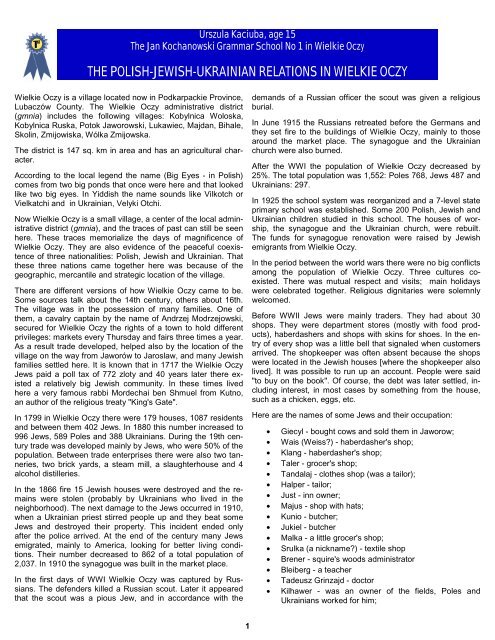
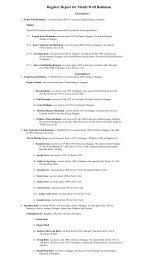
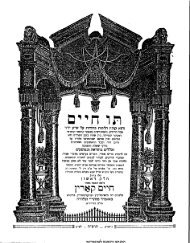
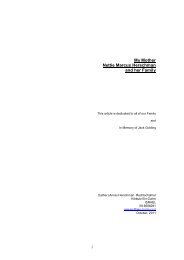
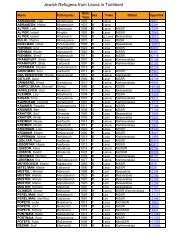
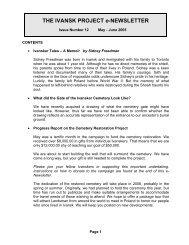
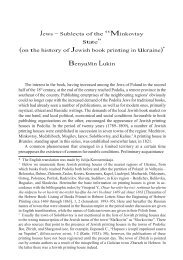
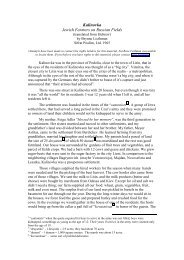
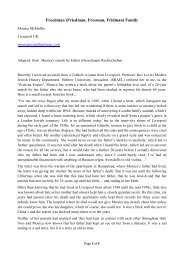
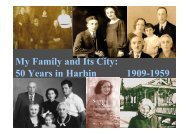

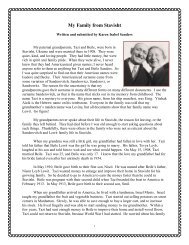

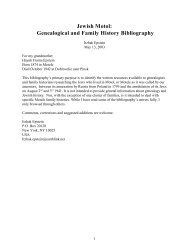
![Carta de Jaime Cesar [Negro] Lipovetzky - JewishGen KehilaLinks](https://img.yumpu.com/19183893/1/190x245/carta-de-jaime-cesar-negro-lipovetzky-jewishgen-kehilalinks.jpg?quality=85)